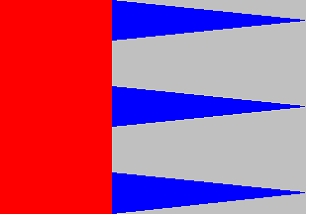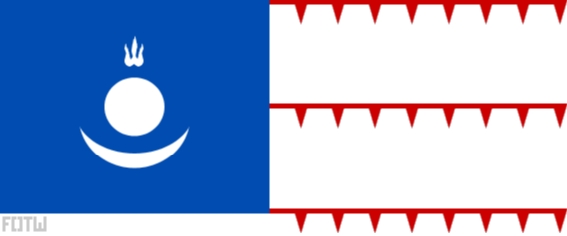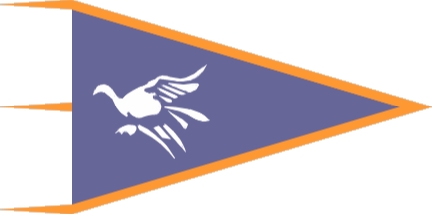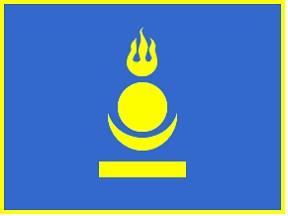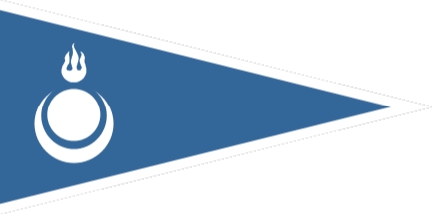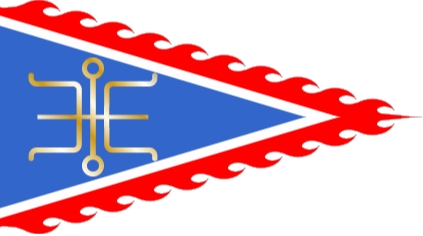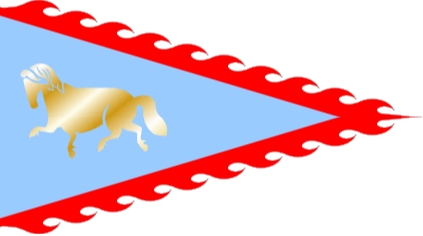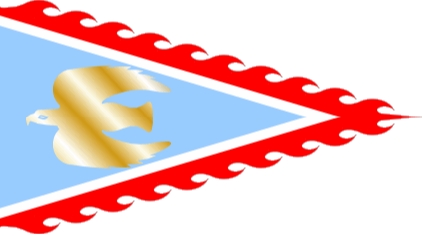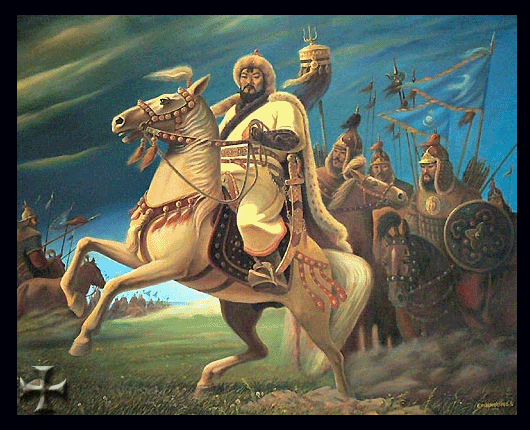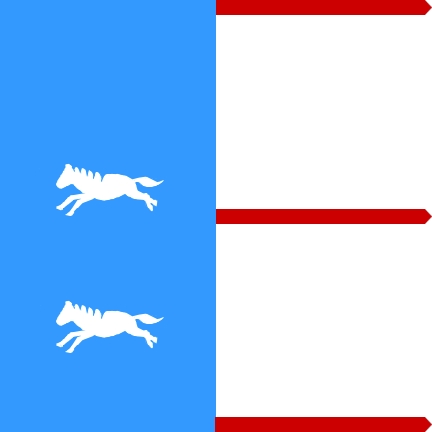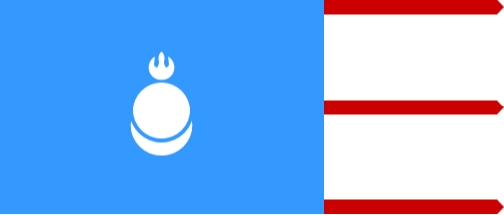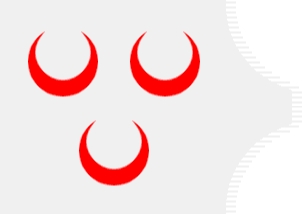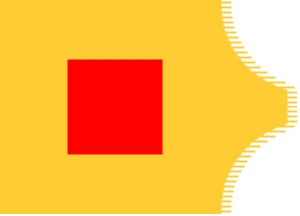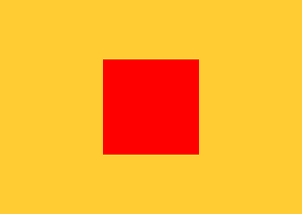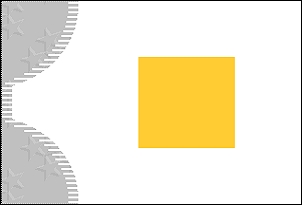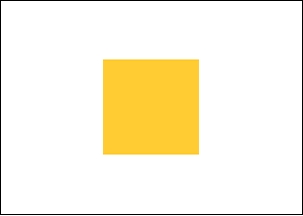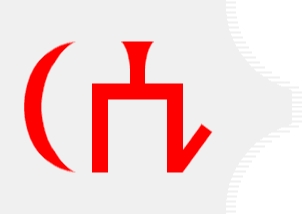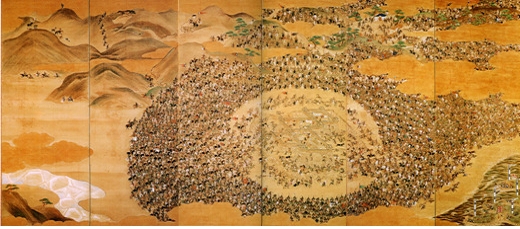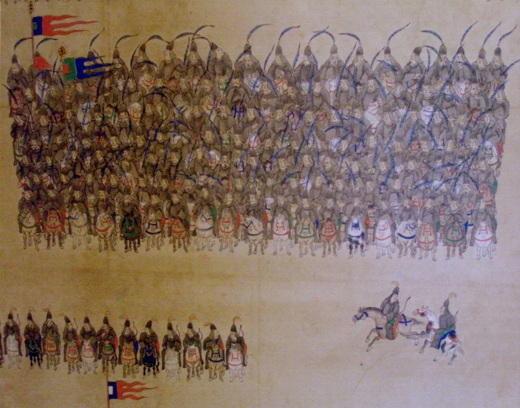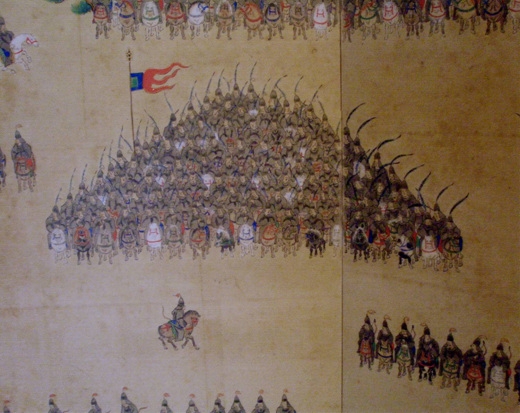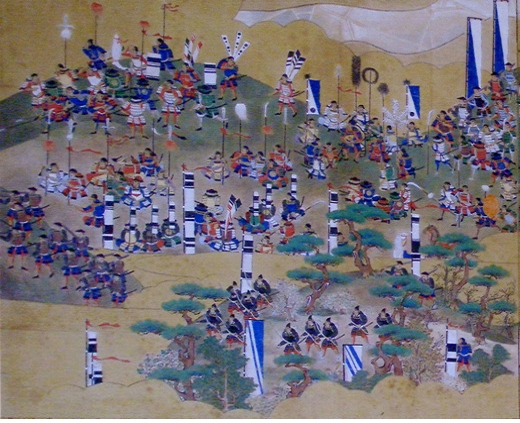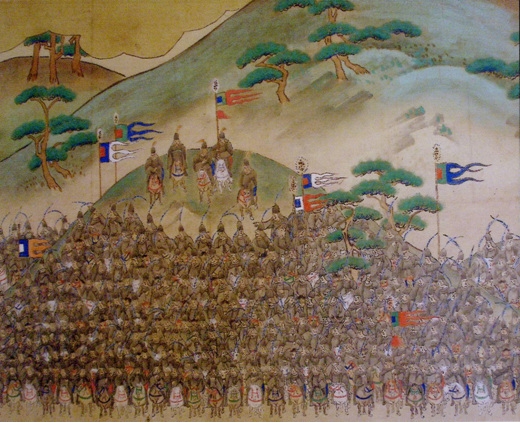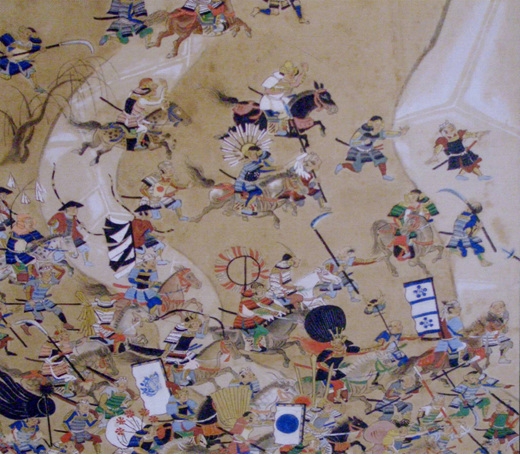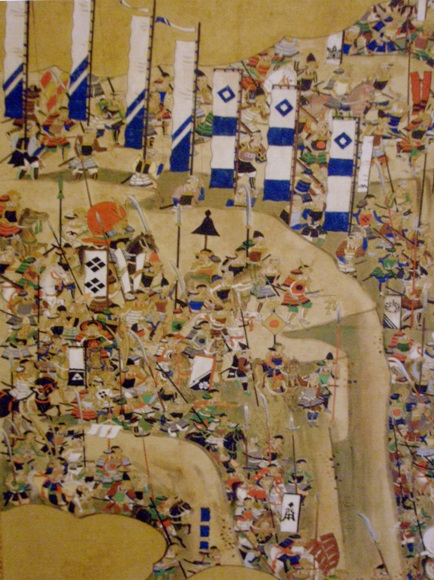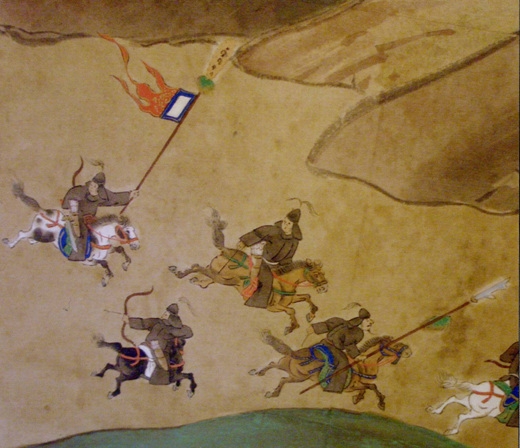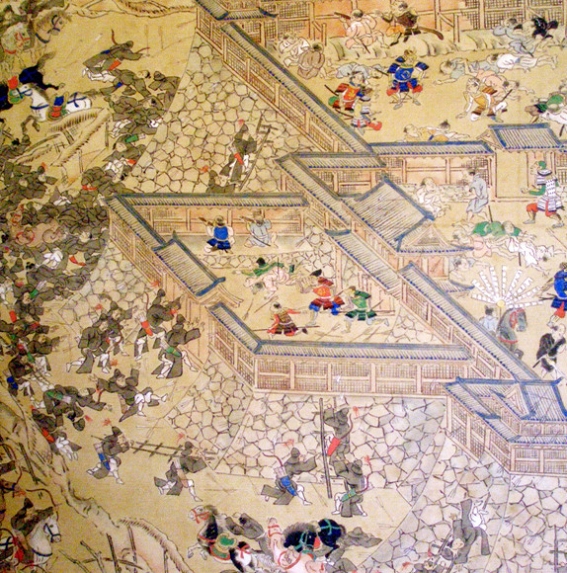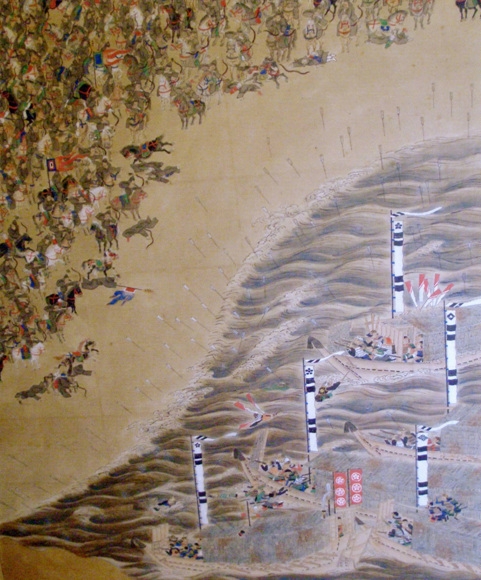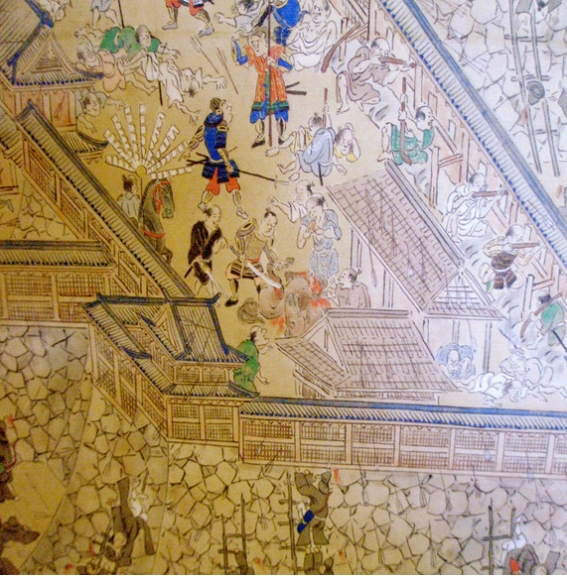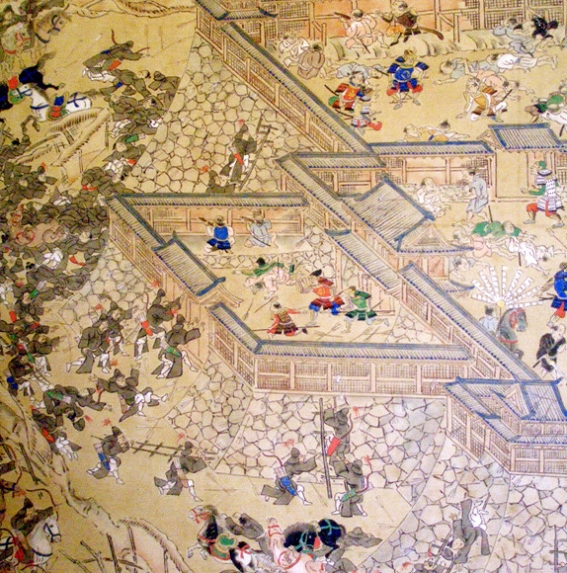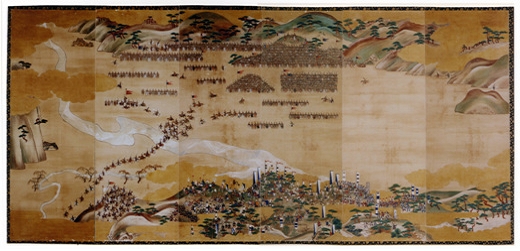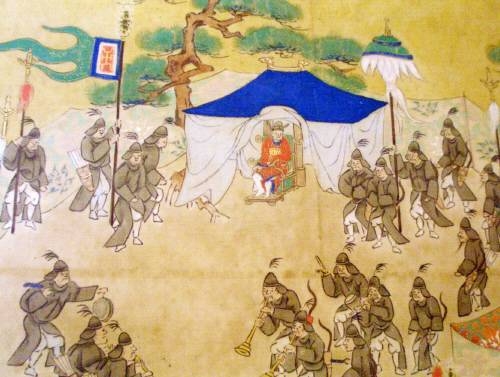조명 연합군의 깃발은...징기스칸 당시의 몽골 깃발입니다
[대륙조선사연구회: 홍진영] 09-02-03 11:11
밑의 첫뻔째 깃발은 징기스칸 통치 당시의 몽골깃발이랍니다.
그 밑의 깃발들이 진짜 징기스칸 당시의 몽골깃발이란 왜놈 후손들의 물타기 자료도 있으나...왜놈 자손들의 근세에도 여전한 교활헌 역사왜곡을 보건데 그저, 몽골로이드들 중...각 소수부족들의 깃발 중 지들과 좀 비슷한 문양을 껴 넣었단 인상이 짖습니다. 일본 아이들 껀...나름대로 일부만 참고 가치가 있을 뿐이란 것이죠.
북유럽(러시아?) 박사가 고증한 맨 위의 징기스칸 통치기 몽골깃발 주장은 자신이 본 몽골지도에서...징기스칸 점령지의 표시에..모두 저 첫번째 표시가 되어 있었단데 있답니다.
헌데...아주 쑈킹하게도...임란당시의 조명 연합군들 깃발과 똑같습니다.
이 무슨 조화일까요?
뭔 역사서에 지명이 어떻고 저떻고 보다 너무도 확실한 증거...그 나라의 모든 정체성을 뜻하는 깃발...그게 조선과 명나라...몽골이 같은 겁니다.
차가타이한국의 깃발이...페르시아 깃발과 같은 패턴인 점도 인상적이며..제 예상대로 흰색을 상징한 백제와의 연관성이 짙습니다.
비록, 왜노들 자손들이 빤스도 제대로 못 입은 지 조상들의 갑옷을...모두 입혀 그린 뻥은 있겠으나...정유왜란 때의 울산성 전투도를 보면...실로 경악스럽습니다.
조명 연합군이 징기스칸 통치기의 몽골 상징인...삼지창 모양의 휘가 휘날리는 치우기 형상을 들고 있습니다.
조선군과 명군의 갑주차이도...차이가 거의 없는 선비족(탕구트&몽골군&여진족)식 갑주고...다르다면...조선군 투구엔 톡(纛)이 달려있고...명군의 투구엔 공작 깃털이 달렸단 차이입니다.
저 명군의 공작 깃 장식은...페르시아 지역의 전통 투구장식입니다.
한 마디로...명나라는...몽골의 방계이며...서남아에 있던 나라란 겁니다.
서남아에는 당시 동 차가타이한국이 있었고...그 동부지역이 모굴리스탄으로 불이던 나라였습니다. 모굴리스탄이 명나라(大明)이며..무굴이란 말이며...그게 몽골족 전통을 그대로 지닌 나라란 말이 되는 겁니다. 조선과 명의 차이는...차가태한국령 서남아와...선비계 몽골령 동아시아란 것밖엔 차이가 없어 보입니다.
대원 울르스(원나라)란 자체도 북방 시베리아의 말갈족들이 주류라기보다는 유라시아 중부 온대 중위도 지방들의 탕구트나 선비계 족속들이 주류인 연합으로 봄이 맞을 듯합니다.
새삼...조선과 명나라...몽골의 정체성 확인의 기본 중 기본인...그 나라 깃발들에 대한 연구가 턱없이 엉성한 먹물통님들의 무성의에...분노의 혀를 내두르는 오늘입니다.
정말 이 나라 역사학계는...기본 중 가장 기본도 찾아보지 않고..왜놈들이나 중국아이들이 주는 정보만 받아 처먹으며...원전해석이 어떻고 저떻고 하는 식충들로 보이는 오늘이기도 합니다.
************************
Early Mongol flags
Last modified: 2008-09-13
Mongolia
Mongol Flag, circa 1310
by Phil Nelson
This flag is shown in Znamierowski's World Encyclopedia of Flags.
Phil Nelson, 18 February 2000
------------------------
Flag of Chinghiz-khan
Modern 'scientists' have very many reconstructions of flag of Chinghiz-khan but all they are very doubtful. Ancient chronicles says about white and black banners of Chinghiz-khan with 9 tails. White colours was sacred in that times. Black colour was the colour of gods of death. May be it was real horse`s tails. May be it was cloth banner with 9 tails. The number of tails was showed the rank of commander. The symbol of Chinghiz-khan was a falcon with a crow in his claws. Poor ancestor of Chinghiz, Boduanchar, was the hunter. He made his job with tamed falcon. Source. V.Jan, novel 'Batu-khan' Mongol scientists think that the falcon was the main element of the white banner of Hiad-borjigin tribe (E.Har-Davan "Chinghis the Commander and His Successors"), father-tribe of Chinghiz-khan.
Victor Lomantsov, 22 April 2001
-------------
Flags of Mongol Empire
by Nozomi Kariyasu
by Nozomi Kariyasu
Scaned images of three flags (two different flags) from photo of 700th anniversary of birth of Mongol Empire Festival in Mongolia 2006. They used two flags:
1 blue triangle bearing white bird with red fringe
2 blue rectangle bearing white flame sun and moon like a part of soyombo with three red long tails.
Nozomi Kariyasu, 7 October 2006
by Eugene Ipavec
Mongol Empire Flag - white horse on blue rectangle flag. Image made after Nozomi Kariyasu photos made in Mongolian Military Museum in Uran Bator in June 2008.
by Eugene Ipavec
Mongol Empire Flag, XIV c. - white bird on blue triangle flag. Image made after Nozomi Kariyasu photos made in Mongolian Military Museum in Uran Bator in June 2008.
by Eugene Ipavec
Mongol Empire Flag - yellow flame, sun and cresent on blue rectangle flag. Image made after Nozomi Kariyasu photos made in Mongolian Military Museum in Uran Bator in June 2008.
by Eugene Ipavec
Mongol Empire Flag - white flame, sun and crescent on blue triangle. Image made after Nozomi Kariyasu photos made in Mongolian Military Museum in Uran Bator in June 2008.
Another Mongol Empire Flag from Mongolian Military Museum - white bird on blue triangle.
------------------------
Historical flags from Mongolian Empire festival book
Several flags from book:
on-the-spot report of celebration ceremony in Mongolia"
Publisher: Huihueng Group Hongkong
Editor: 牧人 No English available on the book
Number of pages: 162
Size of the book: 27 cm X 26cm X 2.5 cm
ISBN: Not available
Date of publishment: Jun 2006
To celebrate 800th anniversary of rise of Mongol Empire Phoenix TV Hoingkong made documentary programme of Genghis Khan's festival in Mongolia and at the same time published the book. Chinese title cannot be found among Japanese-Chinese character. I bought this book in Ulan Bator. They call Gengis Khan rera flag as Sulde flags.
Nozomi Kariyasu, 26 August 2008. Images below:
by Eugene Ipavec
Gold bow arrow on blue triangle flag.
by Eugene Ipavec
Gold horse on blue triangle flag.
by Eugene Ipavec
Gold bird on blue triangle flag.
by Eugene Ipavec
Two white horses on blue rectangle flag.
by Eugene Ipavec
Soyonbo variant.
--------------
Flags in Catalan Atlas, 1375
In the Catalan Atlas, the distribution of flags of four main Mongol khanates is based mostly on the "Book of Marco Polo" and "Libro del conoscimiento de los reinos". In some cases, the flags above the cities are not the correct ones, considering the then state boundaries. It might be discussed if these flags were really used, although they might be partly based on real-life informations. Although other classifications are also possible (as noted below), all the flags are classified here as Mongolian, because the rulers of three western khanates were nominally vassals of the Grand Khan and the state boundaries generally do not allow identification of a khanate with a single modern state.
Description of the flags see below. Sources:
[1] Polo, Marco: Milion (Original title: Il Milione di Marco Polo) Zagreb: Mladost, 1954
[2] Enciclopedia universal ilustrada, vol. XXI, Espan~a Madrid: Espasa-Calpe S.A.,
1968
[3] Istorija otkric'a i istraz<ivanja, vol. I: Poc<etak istraz<ivanja; Mladinska knjiga, Ljubljana, 1979; Original title: A History of Discovery and Exploration, vol. I: The
Search Begins;(C) 1973 Aldus Books Limited, London
[4] Web page about Guyuan, Hebei (in Italian):
crioracle.cri.com.cn/italian/panorama/Viaggiare/Weng%20Yi/articoli/Guyuan.htm
[5] "Book of Marco Polo" at Biblioteca Italiana (in Italian):
www.bibliotecaitaliana.it/ScrittoriItalia/catalogo/show-text.xq?textID=mets.si20\3
[6] Wikipedia page about the Timurid dynasty: en.wikipedia.org/wiki/Timurid_Dynasty
[7] Libro del Conoscimiento. Viajes medievales, vol. I Madrid: Fundacio'n Jose'
Antonio de Castro, 2005 ISBN 84-96452-11-5 (complete edition) ISBN
84-96452-12-3 (vol. I) [e9s50]
[8] Apendices. (Ibid.)
[9] Catalan Atlas - image of the part showing Persia:
www.georgeglazer.com/maps/world/catalanasia.JPG
[10] Catalan Atlas - image of the part showing central Asia:
tigger.uic.edu/~adsera/i8_0000h.jpg
Tomislav Todorovic, 21 April 2007
This book in our Biliography as [c2q75]:
Title: Mapamundi vol dir aytant com ymage del m? ?Medium: chart
Languages: Catalan; Latin
Authors:
* Cresques Abraham / כרשכש אַבְרָהָם;
* Jafud?Cresques / כרשכש יְהוּדָה / Jehud?Cresques /
Jaume Ribes
Title in English: Mapamundi, image of the world and of the regions there are on Earth and the various peoples which inhabit it
Publisher: Corona de Arag? Palma de Mallorca
Date: 1375
Edition: 1st
Height: 65 cm
Width: 50 cm
Pages: 6
Remarks: So called 밅atalan Atlas?or 밅harles Quint Atlas?
António Martins-Tuválkin, 23 April 2007
Empire of the Grand Khan
by Tomislav Todorovic
The silver flag with engrailed fly, charged with three red crescents, is hoisted above numerous cities held by the Grand Khan. The name of the country, Cathay (spelled Catayo), is also inscribed on the map (so the flag might be classified as Chinese, too). The cities with the flag which can easily be identified are [1, 2, 3]: Cambaluc (spelled Chambalech), Grand Khan's capital (present-day Beijing); Zayton (present-day Quanzhou, Fujian province), the port from which Marco Polo eventually left China; Lop, off the Lop Nor lake, the westernmost city held by the Grand Khan; Camul (spelled Camull; present-day Khamil or Hami, in Xinjiang autonomous region), Sindaciu (spelled Sinacius; present-day Xuanhua, Hebei province) and Ciagannor (spelled Ciagamor; present-day Guyuan, Hebei province [4]), the cities which Marco Polo passed through on the way from Lop to Cambaluc; and Fugui, which might be a misspelling of Fugiu (Fuzhou, Fujian province [5]) - although there is also a city of Fugio (without the flag), Fugui is the one whose location seems to better correspond to the real city. About the flag itself, there seems to be no evidence that the Grand Khan had really used a flag with such design: it seems to be more appropriate to some of other khanates, whose rulers and their Mongol subjects had converted to Islam by the time when the Catalan Atlas was made. In Wikipedia, a black flag with three red discs, which is shown as the Timurid flag [6], seems to be erroneously derived from the Grand Khan's flag described here, whose silver field has darkened by age to almost black and crescents are no longer easy to be recognized as such. Nevertheless, all this seems to speak in favour of the suggestion that a flag of a Muslim khanate might have been attributed to the Grand Khan by the mapmaker.
Tomislav Todorovic, 21 April 2007
Ilkhanate of Persia
by Tomislav Todorovic
The golden flag with the red square in centre is in fact the flag of Persia from the "Libro del conoscimiento de los reinos" [7] (so it might also be classified as Iranian). In the Catalan Atlas [2, 9], it is shown with engrailed fly, except above the city of Hormuz (spelled Hormissiom), where it is rectangular. Of other cities with the flag, those easy to identify are Kerman (spelled Creman), Qeshm (spelled Chesi), Bukhara (spelled Bocar) and Samarkand (spelled Samarchanti), although the last two were actually in the Chagatai Khanate. Curiously, Tabriz, the capital of Ilkhanate, is not shown in the map, although the Il Khan himself is depicted as "King of Tabriz" ("Rey del Tauris").
Tomislav Todorovic, 21 April 2007
Chagatai Khanate
by Tomislav Todorovic
The flag of this khanate, whose ruler Kebek ("Lo rey Chabech") is depicted in the map, is white with a gold square in centre. It has engrailed fly, except above a city called Baldassia [2, 9, 10], where it is rectangular. Of other cities with the flag, those easy to identify are Khotan (spelled Cotani) and "Many cities built by Alexander the Great", in present-day Afghanistan and Tajikistan, which are represented by two cities only [2]. Unlike other Mongol flags in the map, this one is always shown with the sinister hoist (in the attached images as well). The design might be a combination of those of two flags from "Libro del conoscimiento de los reinos": the flag of Persia (see above) and a silver flag with a gold vertical stripe, which was attributed to the "Empire of Almalik" ("Imperio de Armalec"), named after a city, nowadays ruined, in Xinjiang, China, but said to have held northeastern parts of India as well; that flag was also attributed to several Indian states, most notably Sultanate of Delhi ("Reinado de Delini") [7, 8].
Tomislav Todorovic, 21 April 2007
Golden Horde
by Tomislav Todorovic
This flag has engrailed fly and two red charges on silver field (which was almost blackened by age until present time). one of the charges is a crescent and the other looks like a simplified form of the tamga from the flag of Idel Ural. on different copies of the flag, the crescent has different size; it is often smaller than shown here, sometimes even reduced into a simple oblique stroke and conjoined with the other charge into a sigle symmetrical object; the other charge also sometimes lacks the oblique part [2, 3]. It was obviously difficult to draw the charges always the same way. The cities with this flag which are easy to identify are [2, 7, 8]: Sarai, the capital (spelled Sarra) - there is also a depiction of the ruler, "Jani Beg Lord of Sarai" ("Jambech senyor de Sarra"); Tana, present-day Azov, Russia; and Urgench, Uzbekistan (spelled Organci, with a cedilla under the c; nowadays ruined). This flag is a variant of the flag of "Emperor of Sarai" ("Emperador de Sara") from "Libro del conoscimiento de los reinos" [7] and might be the one that had really existed, considering the similarity of its charges with those from the flag of Idel Ural.
Tomislav Todorovic, 21 April 2007
This Fotw.net mirror is sponsored by MrFlag.com (for flag and bunting ). Web design and eCommerce for MrFlag.com by Wired Media .
******************************************
울산 출신 임자 씨 (68,서울거주) 가 수년전부터 보관하고 있던 병풍 형태의 임진왜란 당시 울산성 전투도 (1597년) 전체 3도중 제1도를 사진 출역 형태로 울산시에 기증 했다고 "뉴스허브, 뉴시스 통신사 가 보도 했다.
울산성은 일본군 가도마사 가 40여 일 동안 1만 5,000여 군사를 동원해 축조 한 성으로써 상당히 견고 했던 모양이다. 조명 연합군 5만이 공격을 했으나 일본군 구원군이 오는 바람에 조선군은 사망 1,000여명 부상 3,000여명 그리고 명군이 사망 4,800여명 부상 6,000여명 의 피해를 입고 철수하는 수모를 겪은 성이라고 한다.
일본 왜군 역시 6,000여명이 사망 했으며 성내 왜군은 구원군이 올 때까지 흙을 쪄서 먹고 오줌을 받아 다시 먹으며 까지 지독하게 항전을 계속 했다고 한다.
사진은 그 당시 생생한 모습을 화공이 그린것이라고 한다.
'세계삼한역사 > SINA-신중국' 카테고리의 다른 글
| 나의 廣西 百濟鄕 방문記 「이 먼 곳에는 어이 오셨나요?」 (0) | 2009.04.12 |
|---|---|
| 중국고금지명대사전 (0) | 2009.04.12 |
| 의괘(儀軌) 그 아름다운 자신감을 후손에게! (0) | 2009.04.07 |
| 골란 고원(Golan Heights)과 고란산(皐蘭山) (0) | 2009.03.29 |
| 1840-1945 대륙근현대사상황도(大陸近代歷史狀況圖) (0) | 2009.03.28 |
